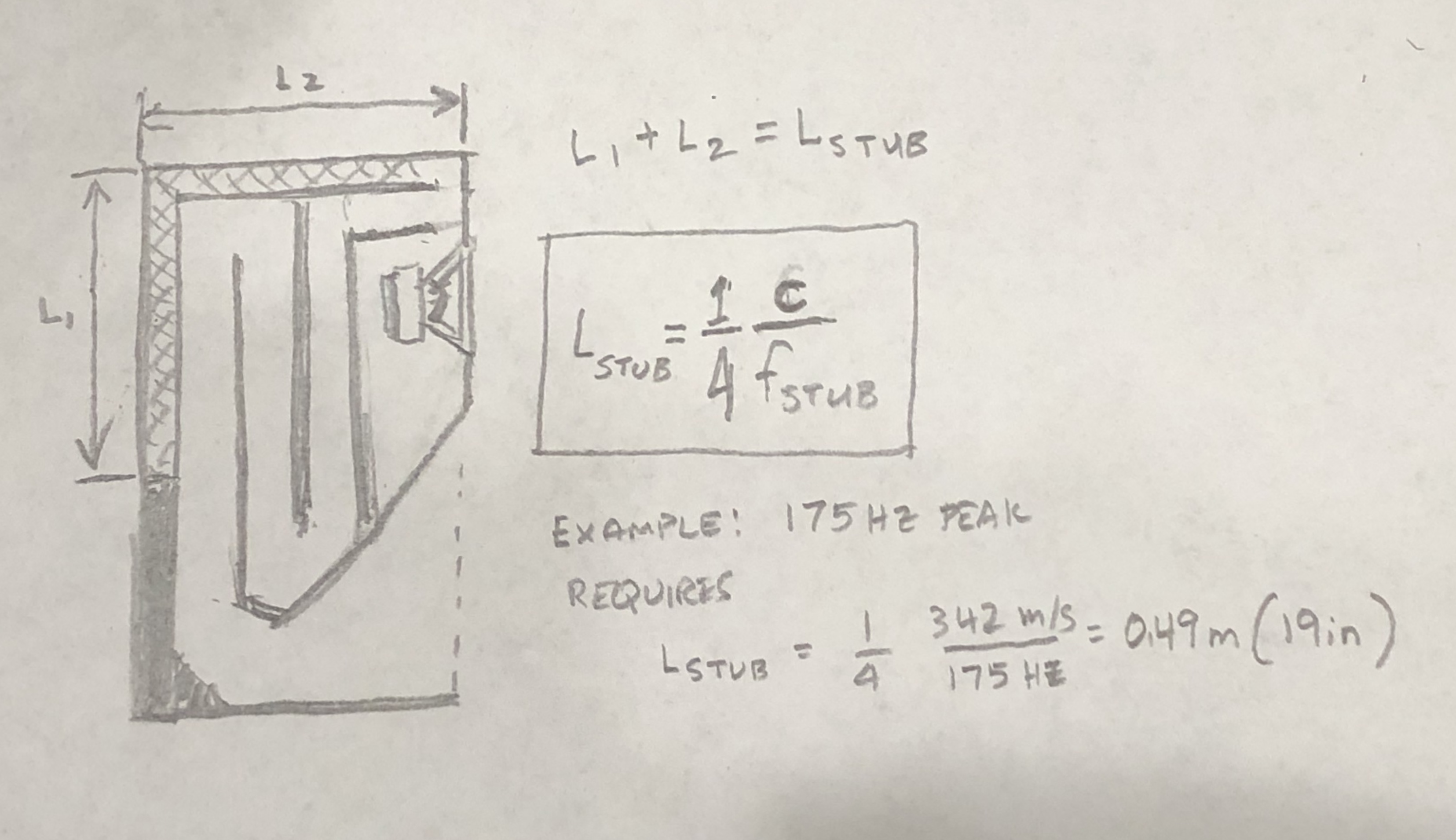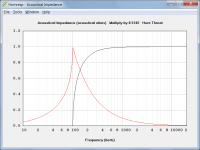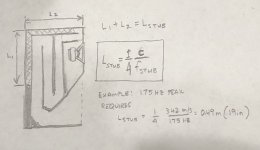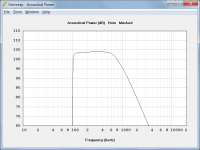I'd thought to title this "How to Slay the Ravenous Bugblatter beast" but that would be too obscure. However, might as well explain it. In the series "Hitch-Hiker's Guide to the Galaxy," a traveler would carry a towel in case he met up with said beast. Upon meeting one, you'd cover your eyes and be safe. For the Beast was so stupid, if you couldn't see him, he couldn't see you. OK, now to bend this around to something having to do with horns ( or waveguides, for this thread they shall be synonyms  )
)
I've read many of the threads here about the various debates that rage over how to design or treat a horn. I claim no audio expertise. Just as well, I see how Dr. Geddes and others are treated! But I do actually own a horn system (Yorkville Unity U15) and have tried some of the various tweaks. Do they work? Maybe...I have almost no way to test. But others do....
But I do actually own a horn system (Yorkville Unity U15) and have tried some of the various tweaks. Do they work? Maybe...I have almost no way to test. But others do....
Once a horn and driver(s) is selected and the speaker built, we have a complete system. But this horn still has potential distortions. For time being, let us consider only those due to shape of the horn: (1) the elusive higher order modes (HOM) reduced by careful design of horn, smooth throat, and stuffing the horn with 30 ppi reticulated foam, preferably after paying royalties to Earl Geddes! (2) Diffraction, not the HOM type (which seems to me to be a special case of diffraction occurring inside the horn) but the type affecting nearly all speakers due to "sharp" edges on the corners, creating a 2nd delayed sound source. And finally the one I wanted to treat in this thread: (3) mouth reflection, also called pipe resonance or reflection. Unlike HOM, this is not controversial. Due to the impedance mismatch between horn mouth and open air, there is a partial reflection of the signal, resulting in a continuous "reverb" to the signal. It is reasonable to expect the extent of the reverb is a function of the dimensions of the horn as well as what, if any, mouth termination is done. It is also possible that some listeners actually LIKE the reverb, considering it part of the horn sound. However, I consider it an unnatural special effect I'd rather listen without.
How, then, to reduce the reverb? There are no doubt many methods. Proper horn design is one. But not everyone can have a horn with a mouth that opens up like a gigantic morning glory What DIY, preferably cheap, methods then are available? Enter the lowly towel.
What DIY, preferably cheap, methods then are available? Enter the lowly towel.
I won't go into detail about it, it is covered in other threads, but one of the best tweaks appears to be simply wrapping a towel around the sharp mouth edge. As good, I presumed, would be a towel "ring" around a mouth otherwise in a baffle as on a U15. The goal is to better match the impedance to open air.
If this tweak has any downside, it must only be the necessity to turn a smooth speaker into something that looks like it has rolled up laundry on it. There are no doubt ways to improve cosmetics, but I will skip that for now.
Ultimately, after this long winded intro, is what I'd like: Is anyone aware of any testing, other than the very limited amount done, that show the efficacy of the towel tweak alone, for a given driver and horn combo? Or better, to try a variety of similar tweaks, and give results as impulse response or similar? This would seem a very simple series of tests but would need a (quasi) anechoic chamber for best results.
I've read many of the threads here about the various debates that rage over how to design or treat a horn. I claim no audio expertise. Just as well, I see how Dr. Geddes and others are treated!
Once a horn and driver(s) is selected and the speaker built, we have a complete system. But this horn still has potential distortions. For time being, let us consider only those due to shape of the horn: (1) the elusive higher order modes (HOM) reduced by careful design of horn, smooth throat, and stuffing the horn with 30 ppi reticulated foam, preferably after paying royalties to Earl Geddes! (2) Diffraction, not the HOM type (which seems to me to be a special case of diffraction occurring inside the horn) but the type affecting nearly all speakers due to "sharp" edges on the corners, creating a 2nd delayed sound source. And finally the one I wanted to treat in this thread: (3) mouth reflection, also called pipe resonance or reflection. Unlike HOM, this is not controversial. Due to the impedance mismatch between horn mouth and open air, there is a partial reflection of the signal, resulting in a continuous "reverb" to the signal. It is reasonable to expect the extent of the reverb is a function of the dimensions of the horn as well as what, if any, mouth termination is done. It is also possible that some listeners actually LIKE the reverb, considering it part of the horn sound. However, I consider it an unnatural special effect I'd rather listen without.
How, then, to reduce the reverb? There are no doubt many methods. Proper horn design is one. But not everyone can have a horn with a mouth that opens up like a gigantic morning glory
I won't go into detail about it, it is covered in other threads, but one of the best tweaks appears to be simply wrapping a towel around the sharp mouth edge. As good, I presumed, would be a towel "ring" around a mouth otherwise in a baffle as on a U15. The goal is to better match the impedance to open air.
If this tweak has any downside, it must only be the necessity to turn a smooth speaker into something that looks like it has rolled up laundry on it. There are no doubt ways to improve cosmetics, but I will skip that for now.
Ultimately, after this long winded intro, is what I'd like: Is anyone aware of any testing, other than the very limited amount done, that show the efficacy of the towel tweak alone, for a given driver and horn combo? Or better, to try a variety of similar tweaks, and give results as impulse response or similar? This would seem a very simple series of tests but would need a (quasi) anechoic chamber for best results.
Last edited:
This is more of a non-post as I don't have time to test anything for a while but interested in your results. I have a SEOS-24 nude sitting as a prototype. What do I have to do to take some measurements? Thickness of towel? Pics of setup?
The only thing I'd be able to do is a before and after towel measurement, mic kept in the same spot, the only thing changed is the towel drapped around the horn. I use Holm Impulse for measurements. In room as I don't have a chamber. Might be tough as you'd have to get down to 500hz or so to see the difference if any. Suggestions?
The only thing I'd be able to do is a before and after towel measurement, mic kept in the same spot, the only thing changed is the towel drapped around the horn. I use Holm Impulse for measurements. In room as I don't have a chamber. Might be tough as you'd have to get down to 500hz or so to see the difference if any. Suggestions?
Due to the impedance mismatch between horn mouth and open air, there is a partial reflection of the signal, resulting in a continuous "reverb" to the signal. It is reasonable to expect the extent of the reverb is a function of the dimensions of the horn as well as what, if any, mouth termination is done. It is also possible that some listeners actually LIKE the reverb, considering it part of the horn sound. However, I consider it an unnatural special effect I'd rather listen without.
How, then, to reduce the reverb? There are no doubt many methods. Proper horn design is one. But not everyone can have a horn with a mouth that opens up like a gigantic morning gloryWhat DIY, preferably cheap, methods then are available?
I believe the mismatch in impedance between mouth and air is due to design flaw. A towel may work, somewhat. Or perhaps as an alternative, plumbers pipe lagging - even has a convenient slit along one side. But the lack of visual elegance bothers me. Somehow, it doesn't seem right.
I really like large morning glory type horns. I'm about to start building another one. This time with a 180 degree backwards sweep to the mouth's lip. Some folks build them really heavy - I question that, again not my idea of elegance.
My (unproven) belief is that a well designed horn resonates in sympathy to the music played. I'm not an expert in these matters, just somebody who is not afraid of thinking out loud.
ToS
Here is perhaps the best background so far on the towel trick:
Factors Affecting Sonic Quality of Mid & HF Horns & Waveguides
Design flaw? Certainly, but how easily to remedy is a good question. I suppose an infinite horn would not have the flaw But lacking that, I'd like to see some one do a series of tests of a specific driver and horn, all the better if it is one that is mouth echo prone ( = a longer horn) and just swap out various mouth treatments. For example, do one without, to prove the existence of the echoes; try the traditional towel around the mouth. Various thicknesses, perhaps other types of fabrics, etc.
But lacking that, I'd like to see some one do a series of tests of a specific driver and horn, all the better if it is one that is mouth echo prone ( = a longer horn) and just swap out various mouth treatments. For example, do one without, to prove the existence of the echoes; try the traditional towel around the mouth. Various thicknesses, perhaps other types of fabrics, etc.
As I understand it, there is an invisible membrane at the horn's mouth, during pressurization (sound) so anything that will disrupt the membrane area will help the impedance transition to free air.
mlee: the resonances are multiples of the horn depth, typically in the 500 Hz to 1000 Hz range. See the linked article above, he explains it clearly.
I like Bouska's article, it's just that we do do a test one better than a rolled up audio magazine
Factors Affecting Sonic Quality of Mid & HF Horns & Waveguides
Design flaw? Certainly, but how easily to remedy is a good question. I suppose an infinite horn would not have the flaw
As I understand it, there is an invisible membrane at the horn's mouth, during pressurization (sound) so anything that will disrupt the membrane area will help the impedance transition to free air.
mlee: the resonances are multiples of the horn depth, typically in the 500 Hz to 1000 Hz range. See the linked article above, he explains it clearly.
I like Bouska's article, it's just that we do do a test one better than a rolled up audio magazine
I suppose an infinite horn would not have the flaw
The attached screenprint shows the normalised throat acoustical impedance of an infinite 100Hz exponential horn. Because there is no impedance mismatch, there are no reflections back down the horn to cause ripples in the throat impedance.
Attachments
I believe the mismatch in impedance between mouth and air is due to design flaw.
All horn loudspeaker systems are less-than-perfect one way or another, as are all direct radiator systems - you just can't get around the physics involved
All horn loudspeaker systems are less-than-perfect one way or another, as are all direct radiator systems - you just can't get around the physics involved. Everything has to be a compromise, including horn mouth size and associated boundary conditions / treatment.
I completely agree, David. It is what has attracted me to building horns. So beautifully simple, yet staggeringly complex in the way they perform. I confess to an innate inability with the languages of maths, physics and music, but that does not stop me admiring their beauty of expression. It is how I use Hornresp, I keep hitting it, like a monkey on a typewriter, until it looks right as an ideal compromise inside my imaginarium. Then and only then, will I start a build.
ToS
If you have a resonance peak, adding a tuned 1/4-wave stub packed with fiberglass can help suppress that particular frequency. Usually I put the stub near where the horn driver is located for best effectiveness. Usually same width as main channel and then about 1in wide and as deep as needed to equal length of 1/4-wave you are trying to suppress.
If you have a resonance peak, adding a tuned 1/4-wave stub packed with fiberglass can help suppress that particular frequency. Usually I put the stub near where the horn driver is located for best effectiveness. Usually same width as main channel and then about 1in wide and as deep as needed to equal length of 1/4-wave you are trying to suppress.
I hear what you say, only I have difficulty visualising it. Semantics, and my lack of intelligence, probably
ToS
I guess Geddes's foam plug acts also as a 1/4 wave resonance absorber. No separate container needed. But best condition is to minimize that wave in the first place.
I like the idea of building McBean's infinite horn You can set up your listening room in the horn's mouth where you like, once the opening is big enough; but how would we manage two or more speakers?
I like the idea of building McBean's infinite horn You can set up your listening room in the horn's mouth where you like, once the opening is big enough; but how would we manage two or more speakers?
Last edited:
I hear what you say, only I have difficulty visualising it. Semantics, and my lack of intelligence, probably
ToS
For example, take this fictitious BLH and let’s assume you have a pesky 175Hz peak, adding a 19in long stub helps to absorb this peak by 3 to maybe 6dB depending on location and stuffing used.
Putting stub entrance near excitation throat helps.
Attachments
Last edited:
For example, take this fictitious BLH and let’s assume you have a pesky 175Hz peak, adding a 19in long stub helps to absorb this peak by 3 to maybe 6dB depending on location and stuffing used.

Putting stub entrance near excitation throat helps.
Ah, now I see and understand exactly what you mean! I am very much in favour of what I call 'mechanical eq' through construction - even though I use a (very nice) guitar eq pedal with my present mono horn playback.
Thank you for making a proper drawing for me, it is the kind of thing that sticks and stays for me. I'm going to keep this very much in mind for my next build.
ToS
I am very much in favour of what I call 'mechanical eq' through construction -
+1, one of my design 'mantras' is the pioneer's 'acoustical solutions to acoustical problems'.
GM
I like the idea of building McBean's infinite horn
I'm not sure that you would like the response below cutoff very much, though
Attachments
I was lying in bed last night and it occurred to me: the stub/Helmholtz won't solve our problem! Yes, it would be good to reduce (say) a 1000 Hz peak. But the mouth reflection issue is one of delay (time) of the entire signal leaving the horn. Per Bouska and others, the distortion is a low-passed and multiply time delayed alternately inverted/not inverted delay of the signal.
- Home
- Loudspeakers
- Full Range
- Reduce mouth resonance in horn




